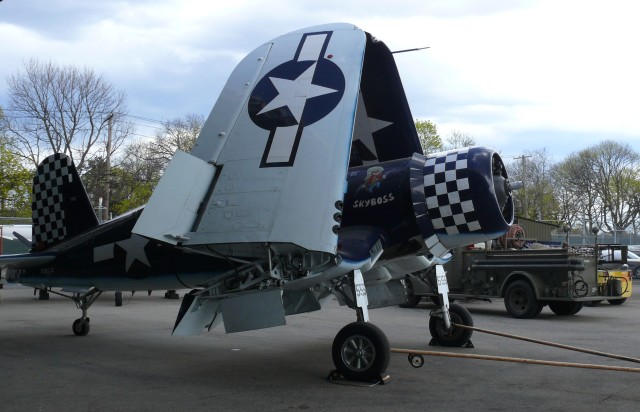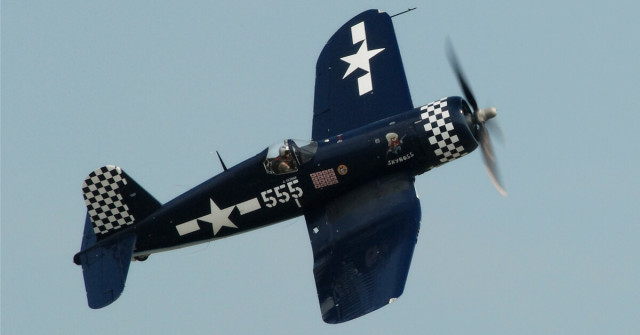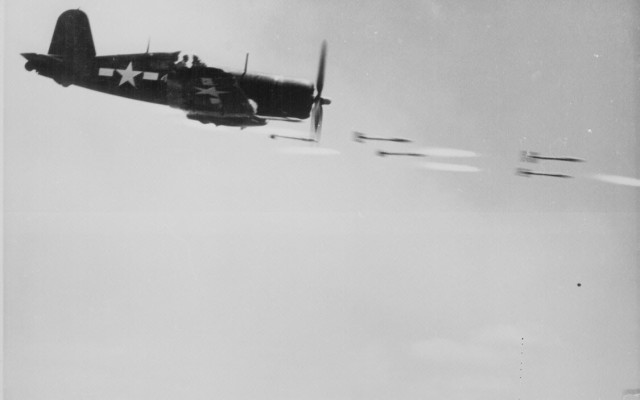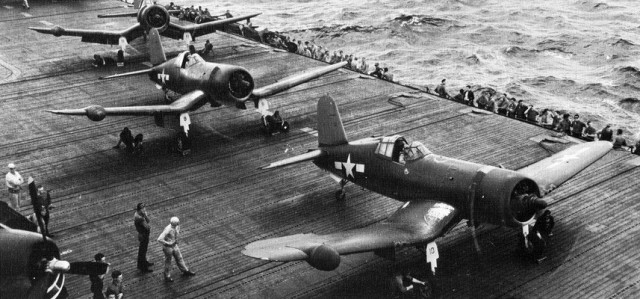SHARES
| FacebookTwitter |
Manufactured by Goodyear in 1942 under license from Vought in Akron, Ohio, Known as Whistling Death Boy by the Japanese the Corsiar was a great Dogfighter as well as a ground support aircraft.
It was originally designed as a carrier-based aircraft it turned out the Corsair had significant landing issues early on. As a result the U.S. Marines became the primary user as a land based fighter in the Pacific Theater. The most notable users being the “Blacksheep” Squadron lead by Major Pappy Boyington.
 Goodyear FG-1 Corsair NX83JC / 67089/555 (c/n 67089) Sky Boss in the markings of VF-53, in the American Airpower Museum in Farmingdale, New York on Long Island. © Ad Meskens / Wikimedia Commons
Goodyear FG-1 Corsair NX83JC / 67089/555 (c/n 67089) Sky Boss in the markings of VF-53, in the American Airpower Museum in Farmingdale, New York on Long Island. © Ad Meskens / Wikimedia Commons
The 2 seater Corsair for sale at controller.com and has the following specifications:
- Only 2, 942 hours total time on the airframe
- Pratt & Whitney R-2800, 2,325 hp s/n FP206410
- Installed 1994 with 696.4 hours since overhaul
- Max.Speed: 450 mph
- Combat Radius: 600 nm
- Max. Takeoff: 12,000 lbs.
- Length: 33′ , Wingspan: 41′, Height: 14′ 8″
- 2 Seats
- Registration #N83JC
- Serial number 67089
For Sale Price: USD $2,495,000
The Corsair in WWII
The Corsair was designed as a carrier-based aircraft and the U.S. Navy received its first production F4U-1 on 31 July 1942, but getting it into service proved difficult. The framed “birdcage” style canopy provided inadequate visibility for deck taxiing. Even more seriously, the machine had a nasty tendency to “bounce” on touchdown, which could cause it to miss the arresting hook and slam into the crash barrier, or even go out of control.
Demand for the aircraft soon overwhelmed Vought’s manufacturing capability, resulting in production by Goodyear and Brewster: Goodyear-built Corsairs were designated FG and Brewster-built aircraft F3A.
Because of the carrier landing issues the Corsair was used as a land-based use by the U.S. Marines. Some Japanese pilots regarded it as the most formidable American fighter of World War II, and the U.S. Navy counted an 11:1 kill ratio with the F4U Corsair.
After the carrier landing issues had been tackled, it quickly became the most capable carrier-based fighter-bomber of World War II.
Corsairs also served well as fighter-bombers in the Central Pacific and the Philippines. By spring 1944, Marine pilots were beginning to exploit the type’s considerable capabilities in the close-support role during amphibious landings. Charles Lindbergh flew Corsairs with the Marines as a civilian technical advisor for United Aircraft Corporation in order to determine how best to increase the Corsair’s payload and range in the attack role.
Continued from Page 1
By the beginning of 1945, the Corsair was a full-blown “mudfighter”, performing strikes with high-explosive bombs, napalm tanks, and HVARs. It proved surprisingly versatile, able to operate everything from Bat glide bombs to 11.75 in Tiny Tim rockets.
The aircraft was a prominent participant in the fighting for the Palaus, Iwo Jima and Okinawa.
Infantrymen nicknamed the Corsair “The Sweetheart of the Marianas” and “The Angel of Okinawa” for its roles in these campaigns. Among Navy and Marine aviators, however, the aircraft was nicknamed “Ensign Eliminator” and “Bent-Wing Eliminator” because it required many more hours of flight training to master than other Navy carrier-borne aircraft. It was also called simply “U-bird” or “Bent Wing Bird”.
U.S. figures compiled at the end of the war indicate that the F4U and FG flew 64,051 operational sorties for the U.S. Marines and U.S. Navy through the conflict (44% of total fighter sorties), with only 9,581 sorties (15%) flown from carrier decks. F4U and FG pilots claimed 2,140 air combat victories against 189 losses to enemy aircraft, for an overall kill ratio of over 11:1.
The Corsair served to a lesser degree in the U.S. Navy. As well as the U.S. and British use the Corsair was also used by the Royal New Zealand Air Force, the French Navy Aéronavale and other, smaller, air forces until the 1960s. (Source: Wikipedia)
Video
Grumman TBM-3U Avenger flown by Charlie Lynch and Vought FG-1D Corsair “Skyboss” – American Airpower Museum at the Geneseo Air Show 2014

Main image by:
By No machine-readable author provided. Cogset assumed (based on copyright claims). – No machine-readable source provided. Own work assumed (based on copyright claims)., CC BY 2.5,
By No machine-readable author provided. Cogset assumed (based on copyright claims). – No machine-readable source provided. Own work assumed (based on copyright claims)., CC BY 2.5,





Δεν υπάρχουν σχόλια:
Δημοσίευση σχολίου